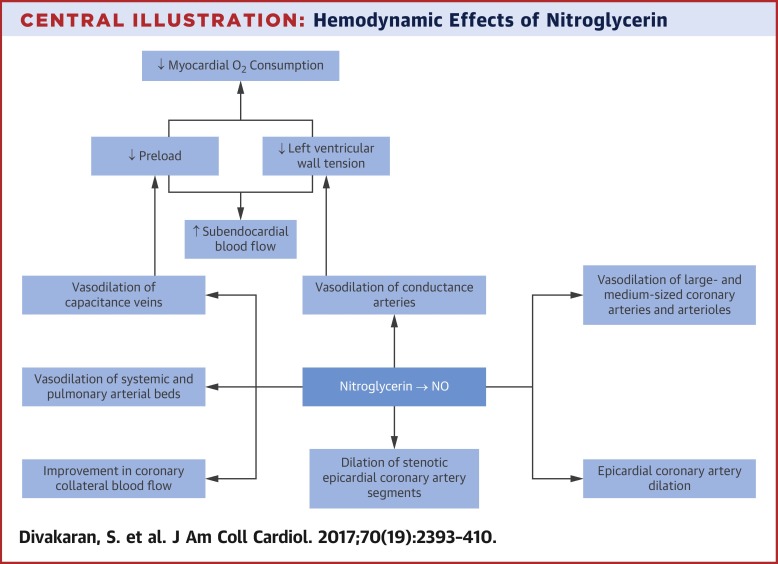当前位置:
X-MOL 学术
›
J. Am. Coll. Cardiol.
›
论文详情
Our official English website, www.x-mol.net, welcomes your
feedback! (Note: you will need to create a separate account there.)
The Role of Nitroglycerin and Other Nitrogen Oxides in Cardiovascular Therapeutics
Journal of the American College of Cardiology ( IF 21.7 ) Pub Date : 2017-11-01 , DOI: 10.1016/j.jacc.2017.09.1064 Sanjay Divakaran , Joseph Loscalzo
Journal of the American College of Cardiology ( IF 21.7 ) Pub Date : 2017-11-01 , DOI: 10.1016/j.jacc.2017.09.1064 Sanjay Divakaran , Joseph Loscalzo

|
The use of nitroglycerin in the treatment of angina pectoris began not long after its original synthesis in 1847. Since then, the discovery of nitric oxide as a biological effector and better understanding of its roles in vasodilation, cell permeability, platelet function, inflammation, and other vascular processes have advanced our knowledge of the hemodynamic (mostly mediated through vasodilation of capacitance and conductance arteries) and nonhemodynamic effects of organic nitrate therapy, via both nitric oxide-dependent and -independent mechanisms. Nitrates are rapidly absorbed from mucous membranes, the gastrointestinal tract, and the skin; thus, nitroglycerin is available in a number of preparations for delivery via several routes: oral tablets, sublingual tablets, buccal tablets, sublingual spray, transdermal ointment, and transdermal patch, as well as intravenous formulations. Organic nitrates are commonly used in the treatment of cardiovascular disease, but clinical data limit their use mostly to the treatment of angina. They are also used in the treatment of subsets of patients with heart failure and pulmonary hypertension. One major limitation of the use of nitrates is the development of tolerance. Although several agents have been studied for use in the prevention of nitrate tolerance, none are currently recommended owing to a paucity of supportive clinical data. Only 1 method of preventing nitrate tolerance remains widely accepted: the use of a dosing strategy that provides an interval of no or low nitrate exposure during each 24-h period. Nitric oxide's important role in several cardiovascular disease mechanisms continues to drive research toward finding novel ways to affect both endogenous and exogenous sources of this key molecular mediator.
中文翻译:

硝酸甘油和其他氮氧化物在心血管治疗中的作用
硝酸甘油在 1847 年最初合成后不久就开始用于治疗心绞痛。 从那时起,发现一氧化氮作为生物效应物并更好地了解其在血管舒张、细胞通透性、血小板功能、炎症和炎症中的作用。其他血管过程通过一氧化氮依赖性和非依赖性机制提高了我们对血液动力学(主要通过电容和电导动脉的血管舒张介导)和有机硝酸盐疗法的非血液动力学效应的认识。硝酸盐可从粘膜、胃肠道和皮肤迅速吸收;因此,硝酸甘油可通过多种途径以多种制剂形式提供:口服片剂、舌下片剂、含服片剂、舌下喷雾剂、透皮软膏和透皮贴剂,以及静脉注射制剂。有机硝酸盐常用于治疗心血管疾病,但临床数据限制其主要用于治疗心绞痛。它们还用于治疗心力衰竭和肺动脉高压患者。使用硝酸盐的主要限制之一是产生耐受性。尽管已经研究了几种用于预防硝酸盐耐受性的药物,但由于缺乏支持性临床数据,目前没有一种药物被推荐。只有一种预防硝酸盐耐受的方法仍然被广泛接受:使用给药策略,在每 24 小时期间提供无或低硝酸盐暴露的间隔。一氧化氮'
更新日期:2017-11-01
中文翻译:

硝酸甘油和其他氮氧化物在心血管治疗中的作用
硝酸甘油在 1847 年最初合成后不久就开始用于治疗心绞痛。 从那时起,发现一氧化氮作为生物效应物并更好地了解其在血管舒张、细胞通透性、血小板功能、炎症和炎症中的作用。其他血管过程通过一氧化氮依赖性和非依赖性机制提高了我们对血液动力学(主要通过电容和电导动脉的血管舒张介导)和有机硝酸盐疗法的非血液动力学效应的认识。硝酸盐可从粘膜、胃肠道和皮肤迅速吸收;因此,硝酸甘油可通过多种途径以多种制剂形式提供:口服片剂、舌下片剂、含服片剂、舌下喷雾剂、透皮软膏和透皮贴剂,以及静脉注射制剂。有机硝酸盐常用于治疗心血管疾病,但临床数据限制其主要用于治疗心绞痛。它们还用于治疗心力衰竭和肺动脉高压患者。使用硝酸盐的主要限制之一是产生耐受性。尽管已经研究了几种用于预防硝酸盐耐受性的药物,但由于缺乏支持性临床数据,目前没有一种药物被推荐。只有一种预防硝酸盐耐受的方法仍然被广泛接受:使用给药策略,在每 24 小时期间提供无或低硝酸盐暴露的间隔。一氧化氮'











































 京公网安备 11010802027423号
京公网安备 11010802027423号